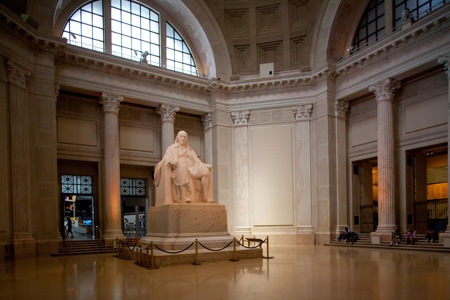
Courtesy Philadelphia CVB
You encounter history at every turn in Philadelphia. The home of Betsy Ross, who, legend has it, designed the American flag, is just up from Elfreth’s Alley, the oldest continuously occupied street in the country.
Right down the street is Christ Church, where you can sit in the same pews used by George Washington and Benjamin Franklin, and then walk a couple of blocks and throw a penny on Franklin’s tombstone for good luck.
Finish the day with dinner at City Tavern, the lovingly and authentically re-created tavern where the Founding Fathers held court.
And, of course, this is the home of two of the most enduring symbols of American freedom: Independence Hall and the Liberty Bell.
“History is our big draw; that is what it is all about here,” said Connor Sharkey, tourism sales manager for the Philadelphia Convention and Visitors Bureau.
However, the City of Brotherly Love, founded by William Penn in 1682 as a model for religious freedom, is much more than just reminders of the past. There are great repositories of art, such as the Philadelphia Museum of Art, the Pennsylvania Academy of Fine Arts and the Rodin Museum, soon to be joined by the world-renowned collection of the Barnes Foundation; impressive entertainment venues, like the gleaming, contemporary Kimmel Center for the Performing Arts and the historic Walnut Street Theatre; a world-class zoo — America’s first; the nation’s third-largest Chinatown; and Fairmount Park, the largest landscaped urban park in the United States.
Philadelphia offers a world of options and opportunities for visiting groups.
Independence National Historical Park is billed as the “nation’s most historic square mile,” and it’s hard to argue with that claim when you consider what took place in the 20-block area of downtown Philadelphia.
If one site can be considered the birthplace of America, that is it. The First and Second Continental Congresses met there, and it was there that the Declaration of Independence, the Articles of Confederation and the Constitution of the United States were debated and signed.
The Declaration of Independence was read publicly for the first time on July 8, 1776, in Independence Square, and the Liberty Bell gained its name and famous crack there and is preserved today in a special building with a glass wall looking out at Independence Hall.
Congress met in the area from 1790 to 1800, when Philadelphia was the nation’s capital, and Presidents George Washington and John Adams lived and worked there.
Also located in the 55-acre park, which is operated by the National Park Service, are the First and Second Banks of the United States; Old City Hall; Franklin Court, where Benjamin Franklin’s house once stood; and City Tavern, the authentic re-creation of the 1773 tavern that was the unofficial meeting place for the First Continental Congress.
Although it is a contemporary structure, the National Constitution Center, which sits at the opposite end of the three-block-long Independence Mall from Independence Hall, tells the story of the Constitution with a variety of innovative techniques — such as a 16-foot-tall, 450-foot-long glass wall with the Constitution printed on it and life-size bronze figures of the men who signed the Constitution — and interactive, multimedia exhibits.











